Discover the Workers’ Cemetery at Giza, where the pyramid builders were honored with structured burials, hieroglyphic inscriptions, and religious symbols. Learn how artifacts, tomb layouts, and funerary art reveal a state-supported workforce, challenging the myth of slave labor in ancient Egypt.
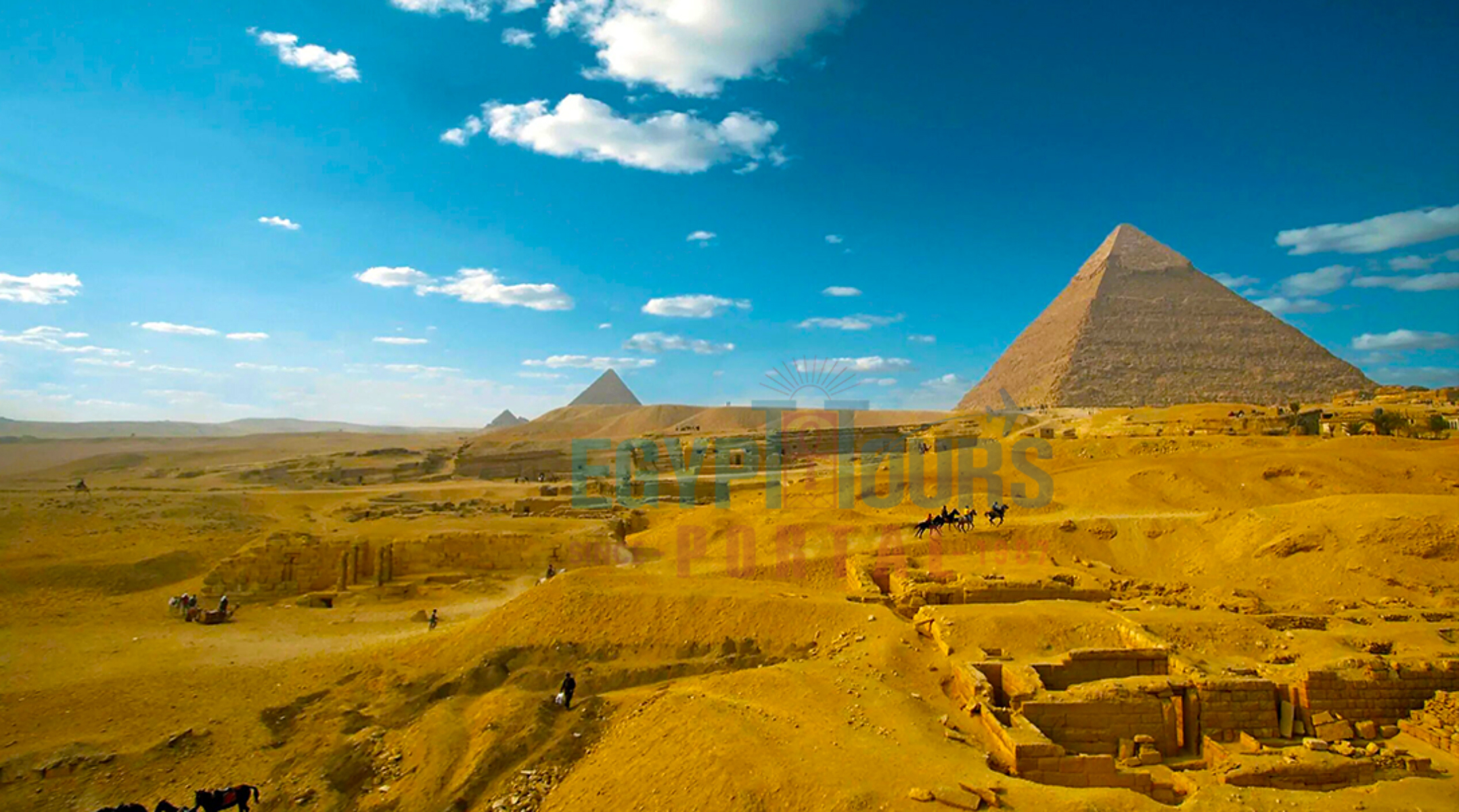
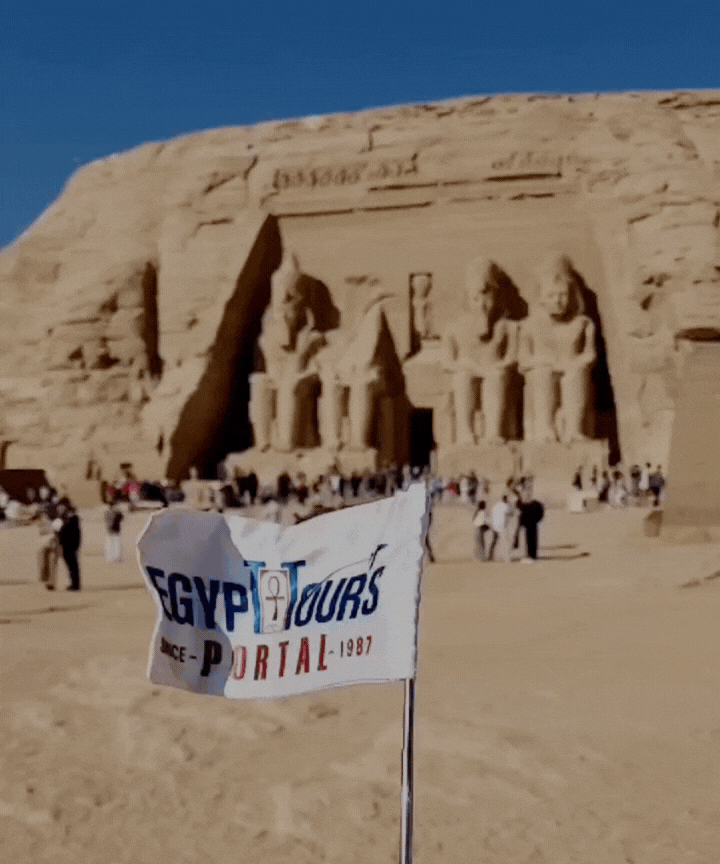
The Giza Workers’ Village is a living example of innovation and power which established the biggest architectural feats on earth. For centuries, the Giza pyramids complex has stood as symbols of ancient Egyptian power, engineering, and religious devotion. However, behind these monumental achievements was an intricate labor system that relied on thousands of skilled workers, artisans, and administrators. While early theories, largely influenced by Greek historians such as Herodotus (5th century BCE), suggested that the pyramids were built by slaves, modern archaeology has refuted this claim.
Excavations at Heit al-Ghurab, commonly known as the Giza Workers’ Village have revealed a state-supported labor force that was well-fed, provided with medical care, and even given proper burials. Located southeast of the pyramids, this settlement dates to the Fourth Dynasty (c. 2613–2494 BCE) and was instrumental in the construction of the pyramids of Khufu (2589–2566 BCE), Khafre (2558–2532 BCE), and Menkaure (2532–2503 BCE). The discovery of the Workers’ Village has revolutionized our understanding of pyramid construction, shifting the focus from pharaohs to the skilled laborers who made these architectural feats possible.
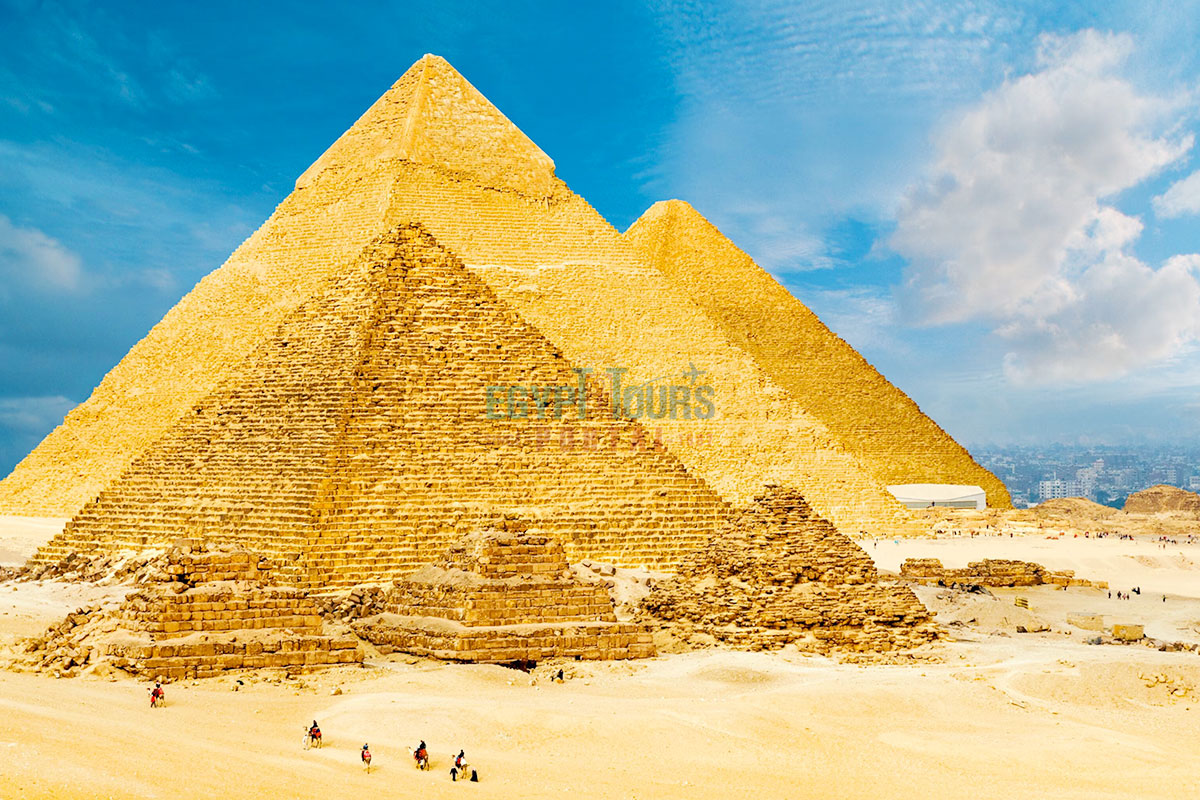
The construction of the pyramids during the Fourth Dynasty represented the peak of ancient Egyptian engineering. The transition from step pyramids to smooth-sided pyramids, pioneered by Pharaoh Sneferu (c. 2613–2589 BCE), culminated in the Great Pyramid of Khufu, which originally stood 146.6 meters (481 feet) high and remained the tallest man-made structure in the world for over 3,800 years. Contrary to popular myths of enslaved labor, The village dates back over 4,500 years to the Fourth Dynasty (c. 2600 BC) and was primarily active during the reigns of Khufu, Khafre, and Menkaure, the pharaohs responsible for the three pyramids at Giza.
These workers were not slaves but rather a highly organized workforce, demonstrating the advanced administrative systems of the ancient Egyptian economy. These workers were not only well-fed but were also housed in a purpose-built settlement, with access to medical treatment and social amenities. It also draws many similarities between Deir el-Medina which was founded in the new kingdom (1550 - 1070 BC) to be the home of all the workers, artisans, and builders who constructed ![]() the greatest historical attractions in the history of Egypt such as the Valley of the Queens, Karnak Temples complex, Hatshepsut Temple, Valley of the Kings, and more.
the greatest historical attractions in the history of Egypt such as the Valley of the Queens, Karnak Temples complex, Hatshepsut Temple, Valley of the Kings, and more.![]()
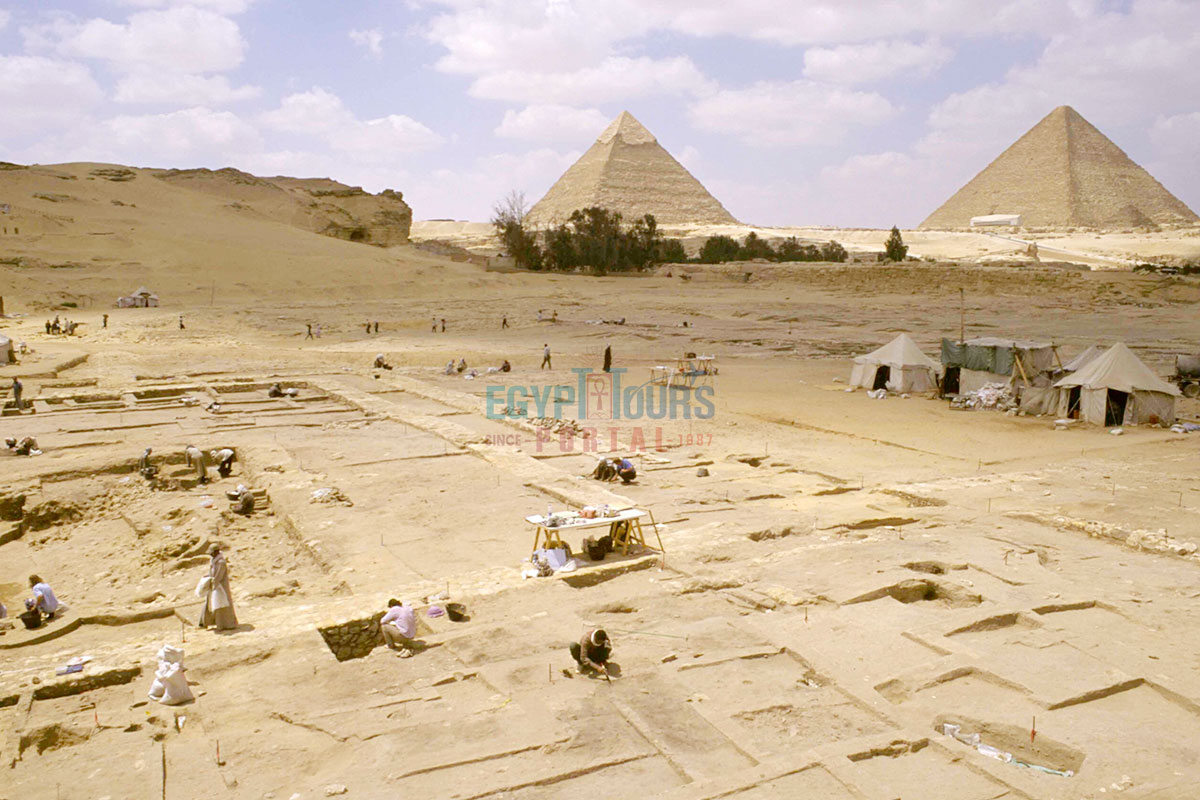
The Giza Workers’ Village was first uncovered in 1988 by American archaeologist Mark Lehner, who, along with the Ancient Egypt Research Associates (AERA) and Egypt’s Supreme Council of Antiquities, led extensive excavations. The site, located southeast of the pyramids, contained remains of ancient Egyptian houses, administrative offices, bakeries, breweries, and a workers' cemetery.
Radiocarbon dating confirmed that the settlement was active during the reigns of Khufu, Khafre, and Menkaure, corresponding to the main phase of pyramid construction at Giza. This discovery provided the first concrete evidence of an organized workforce, fundamentally changing historical interpretations of labor in ancient Egypt.

The urban planning of Heit al-Ghurab demonstrates a sophisticated level of organization. The settlement was divided into distinct areas, including worker barracks, artisan homes, food production facilities, storage complexes, and an administrative center. Three parallel streets ran through the village, forming its main infrastructure. Temporary laborers lived in barracks-style accommodations, with communal sleeping quarters, kitchens, and storage spaces.
Skilled artisans and overseers resided in private stone houses, some featuring courtyards, storage rooms, and multiple chambers, indicating a higher social status. The royal administrative center managed workforce logistics, including rations, work assignments, and tool distribution. Near the settlement, a harbor linked to the Nile River facilitated the transportation of limestone, granite, and imported goods, further supporting the efficiency of pyramid construction.
Discover the fascinating details about the genius and creative minds of Ancient Egyptian Architects.
Read More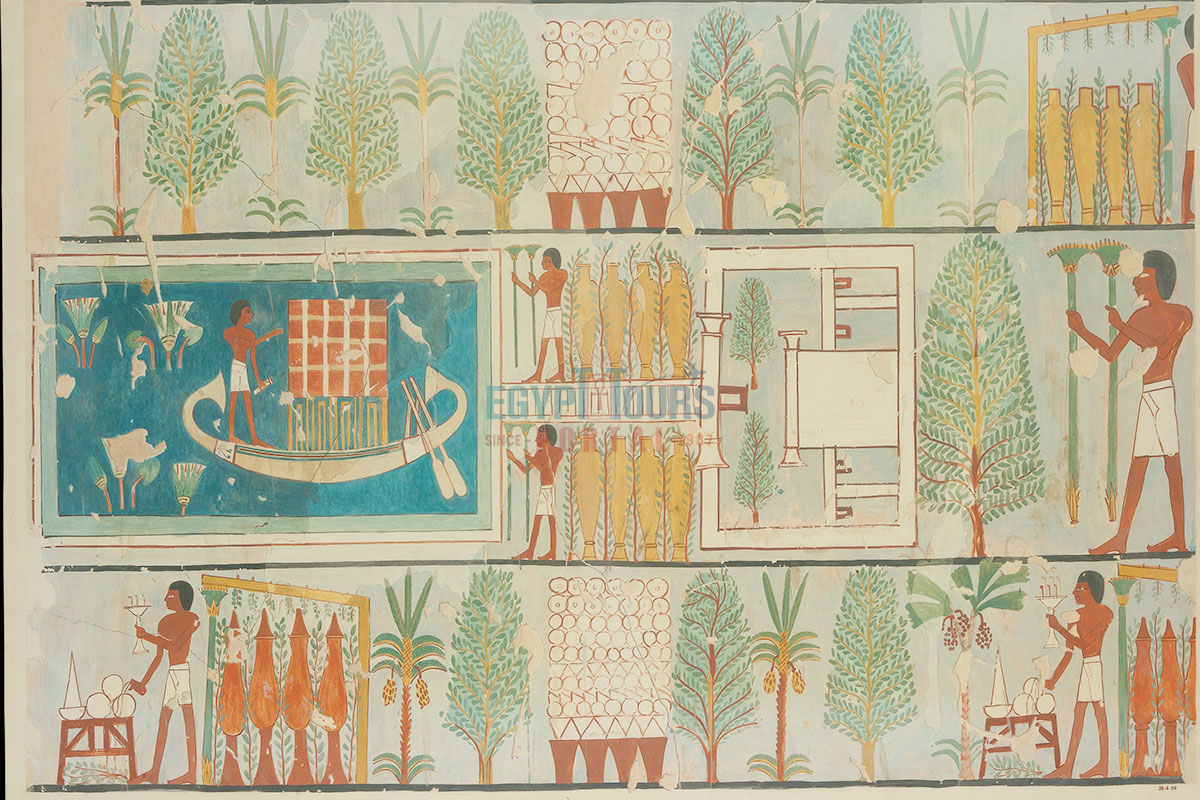
The daily life of the ancient Egyptians in Heit al-Ghurab was structured around labor shifts, communal activities, and state-provided sustenance. Workers were recruited seasonally and served in rotations of two to three months before returning to their home villages. Laborers were organized into crews of approximately 10–20 men, each responsible for specific construction tasks such as stone-cutting, transportation, or masonry.
Archaeological evidence from kitchens and storage pits reveals that workers had access to a high-protein diet, including cattle, sheep, goats, fish, bread, and beer, a higher quality of food than most common Egyptians consumed. Large-scale breweries found at the site indicate that beer was a staple beverage, not only for hydration but as a significant calorie source. The presence of small shrines and artifacts related to religious rituals suggests that workers maintained spiritual practices, reinforcing their connection to ancient Egyptian religion.
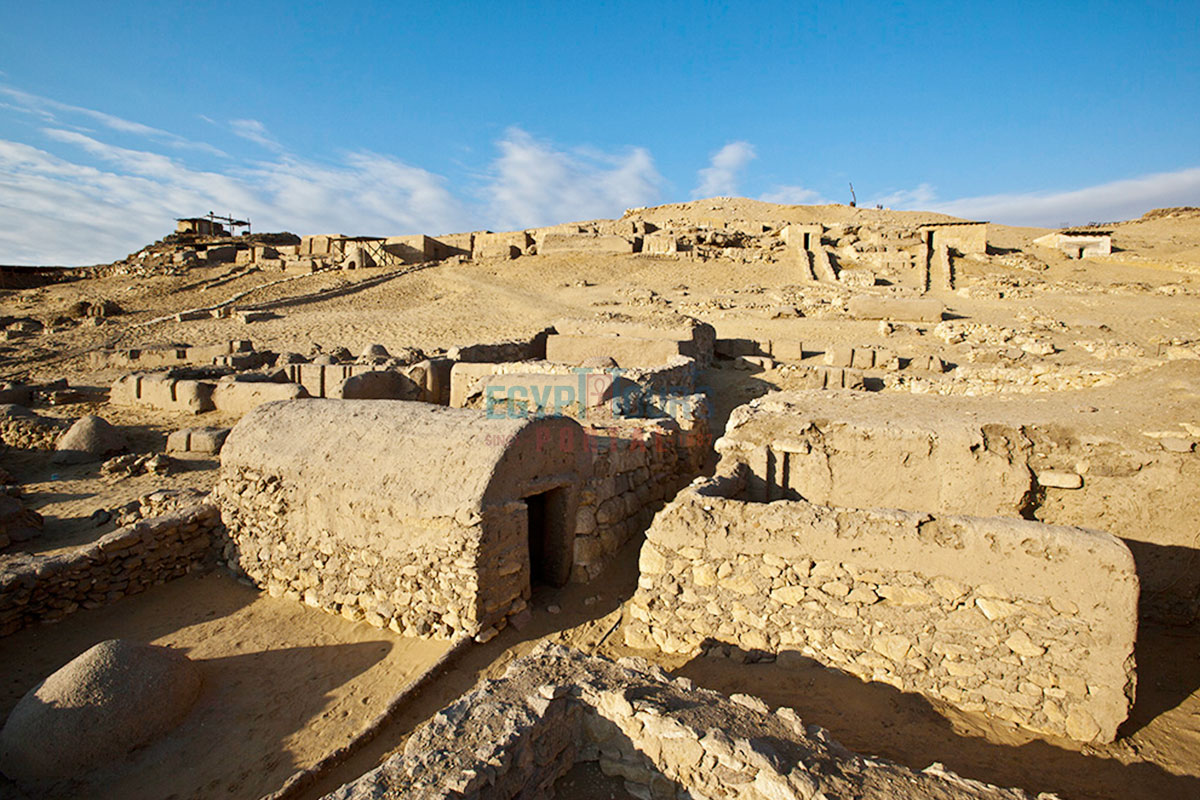
The Workers’ Cemetery, located 500 meters west of Heit al-Ghurab, provides significant insights into the lives and societal status of the pyramid builders. Unlike the grand Egyptian tombs of the ancient Egyptian nobles, the elite, and laborers were buried in modest mudbrick tombs or simple pit graves, yet the fact that they received structured burials challenged the assumption that they were merely disposable workers.
Excavations reveal a hierarchical burial system, with general laborers buried in simple tombs, while skilled artisans, overseers, and foremen were given larger mastaba-style tombs, often placed on higher slopes, signifying social ranking even in death. Hieroglyphic inscriptions on tomb markers provide details of the deceased’s occupations, such as stonecutter, mason, and transport specialist, emphasizing the organized labor system at Giza.
The presence of personal items, including pottery, amulets, tools, and shabti figurines, suggests a belief in the Egyptian afterlife, where workers are expected to continue serving the ancient Egyptian gods. The cemetery’s spatial organization mirrors the hierarchy of the Workers’ Village, reinforcing that these laborers were valued contributors to state projects rather than expendable laborers, reflecting their respected position in ancient Egyptian society.
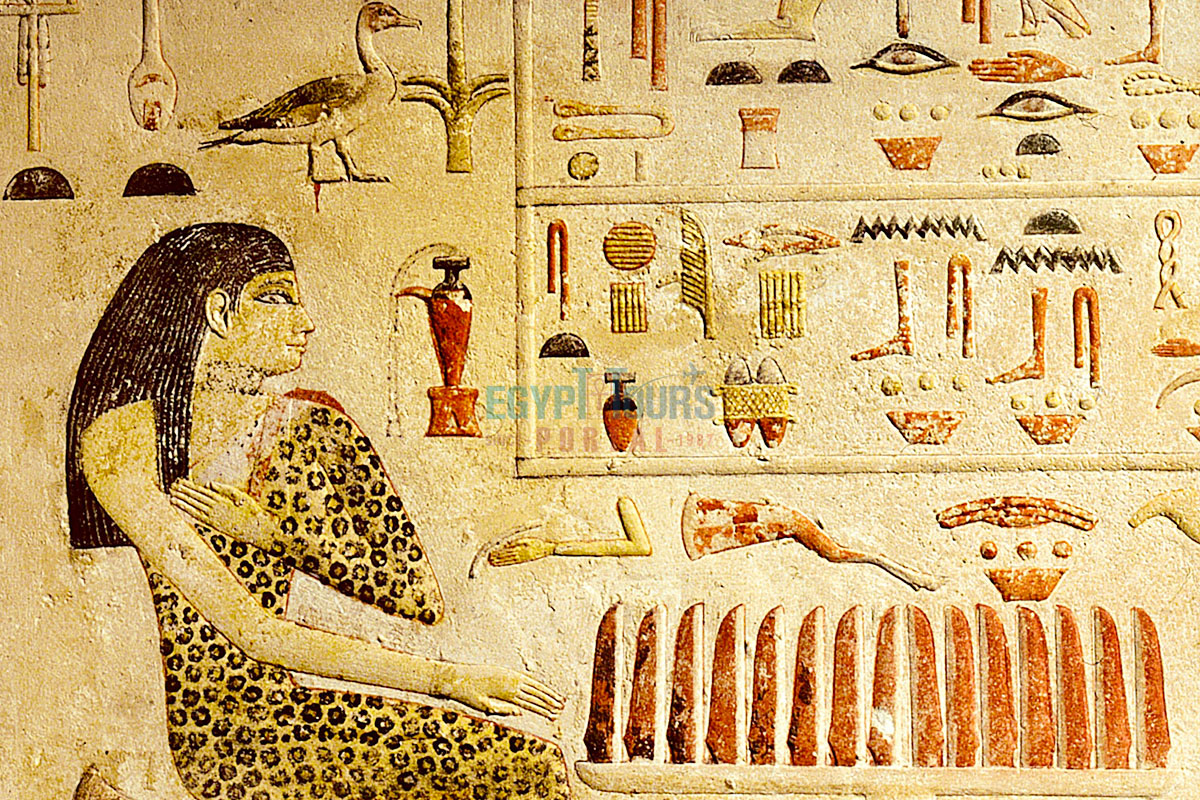
The tombs of pyramid builders, though modest in construction, incorporated artistic and religious elements that reflected their societal roles and spiritual beliefs. Unlike the gold-adorned tombs of the elite, workers’ tombs featured simplified funerary decorations that represent a good example of predynastic ancient Egyptian art, but these still held deep religious significance, reinforcing Egyptian beliefs in the afterlife and divine judgment.
Some tombs contained painted reliefs depicting daily life, including workers performing their trades, such as stone-cutting, tool-making, and transport, intended to honor their professions and ensure the continuity of their skills in the afterlife. Others contained hieroglyphic texts requesting safe passage into the afterlife, written in cursive hieroglyphs, a simplified form of inscriptions found in royal tombs.
The inclusion of burial goods, such as tools, pottery, jewelry, and food offerings, suggests that workers anticipated continuing their labor beyond death. The presence of shabti figurines, small statuettes meant to perform tasks for the deceased in the afterlife, indicates that non-royal Egyptians also believed in ongoing service beyond the mortal world. Some of these figurines bore inscriptions from the Pyramid Texts and Coffin Texts, reinforcing their religious and symbolic function.
Excavations have also uncovered carved stone stelae in some workers’ tombs, depicting deities such as Osiris, Anubis, and Ptah, reflecting their spiritual devotion. The presence of religious ancient Egyptian symbols in non-elite burials suggests that common workers had access to the same theological beliefs as the upper classes, albeit in a simplified form. These findings confirm that workers held religious and social significance in ancient Egyptian society, challenging the outdated notion that they were merely laborers without status or identity.
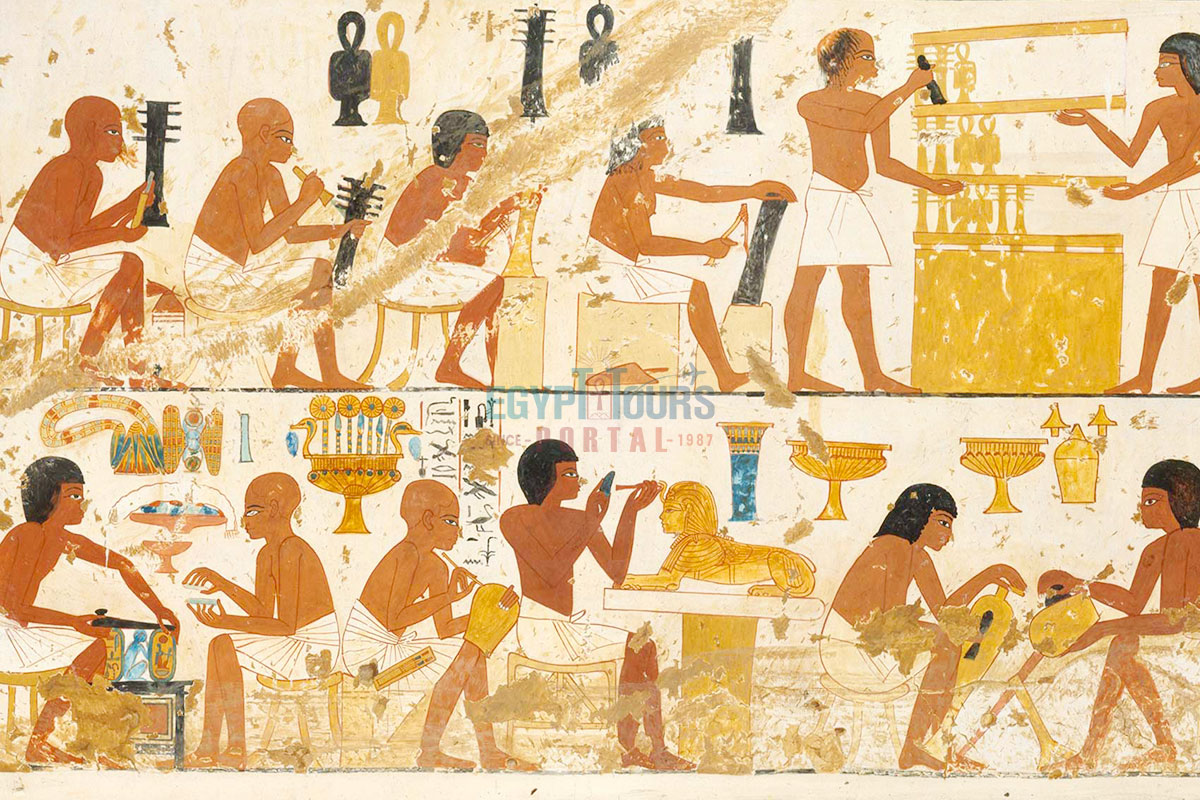
Archaeological evidence from workshops near the settlement has revealed a highly specialized and skilled workforce. The tools and materials found suggest that workers employed sophisticated engineering techniques to construct the pyramids. Copper chisels, dolerite pounders, and wooden sleds were essential for quarrying, shaping, and transporting massive limestone blocks. Advanced measuring tools such as plumb bobs, levels, and rope-stretching devices indicate that Egyptian engineers had a strong understanding of geometry and precision in construction.
The presence of surveying tools at the site suggests that calculations of Egyptian mathematics were used in designing pyramid angles and alignments. Hieroglyphic records indicate that workers were organized into hierarchical teams, often identified by group names such as the “Friends of Khufu” or the “Drunkards of Menkaure.” These team structures ensured efficiency in quarrying, transportation, and on-site construction, allowing for the precise assembly of massive stone structures.
Discover intriguing facts about the daily routines, skills, and brilliant minds & hands of the Egyptian Craftsmen.
Read More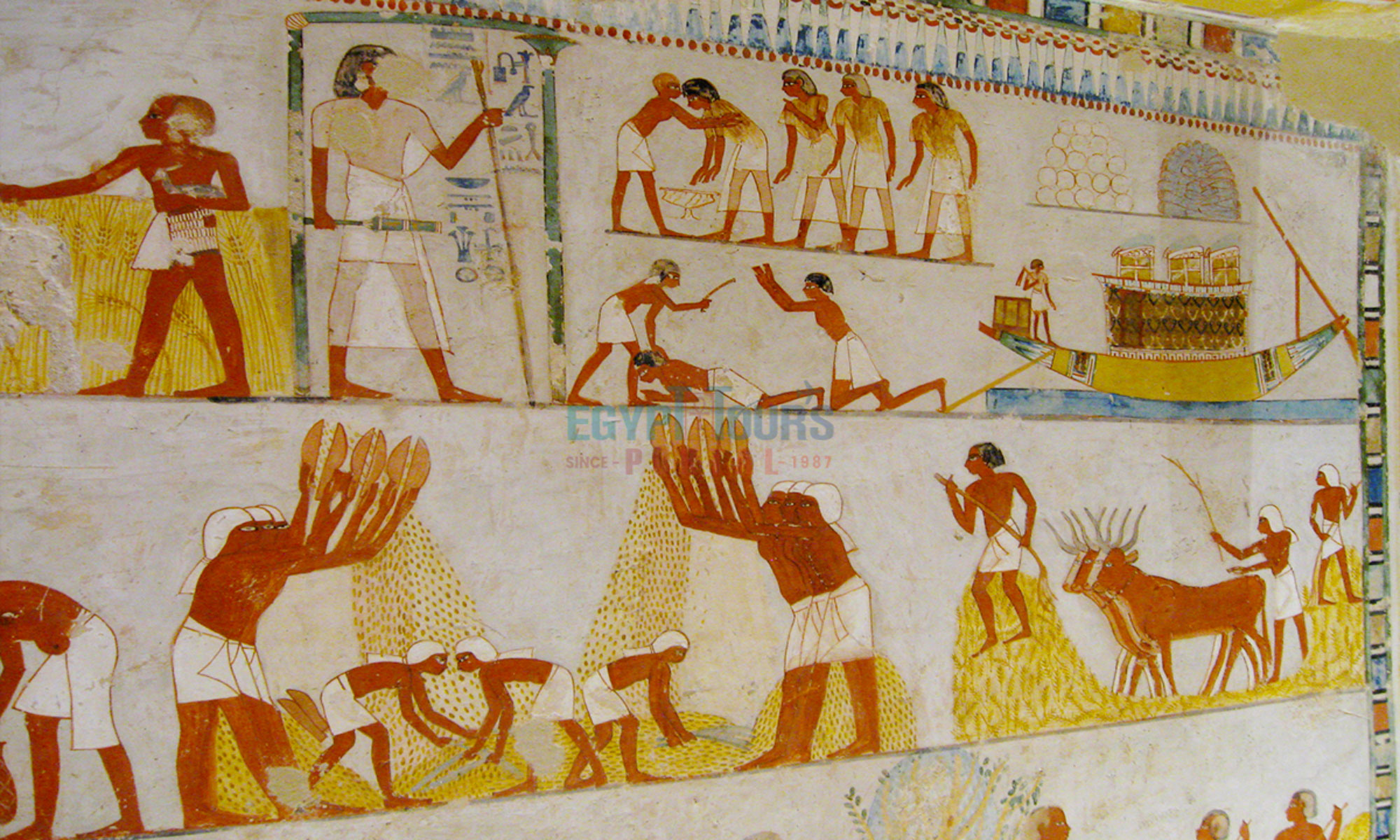
The Workers’ Village reflects a complex hierarchical labor system that governed the ancient Egyptian society. Temporary laborers, often recruited from rural areas, lived in large communal barracks, where they were provided with food and essential supplies. Skilled artisans and overseers, who had permanent positions, resided in stone-built homes with private storage rooms and courtyards, indicating a higher status.
The presence of a medical facility within the settlement is supported by skeletal remains showing evidence of healed fractures, amputations, and dental treatments. Some bones exhibit successful surgeries, including limb realignments and skull trepanation, proving that Egyptian medicine was highly advanced. The state-sponsored welfare system ensured that workers received proper nutrition, medical care, and rest, contradicting theories of forced labor and mistreatment.
Learn all that you can about the different jobs and the well-structured society of ancient Egypt.
Read More
Advances in archaeological technology have significantly enhanced our understanding of life in the Workers’ Village. Researchers have used ground-penetrating radar, 3D modeling, and isotope analysis to reconstruct the diet, health, and mobility of workers. DNA testing has helped establish familial relationships among buried individuals, suggesting that some workers were part of multi-generational labor families.
The Egyptian Ministry of Tourism and Antiquities, in collaboration with international institutions such as the American Research Center in Egypt (ARCE) and UNESCO, has implemented conservation programs to protect the Workers’ Village and Cemetery from erosion, tourism damage, and modern development. These initiatives include controlled excavation, site monitoring, and digital archiving, ensuring that future generations can continue studying this important site.
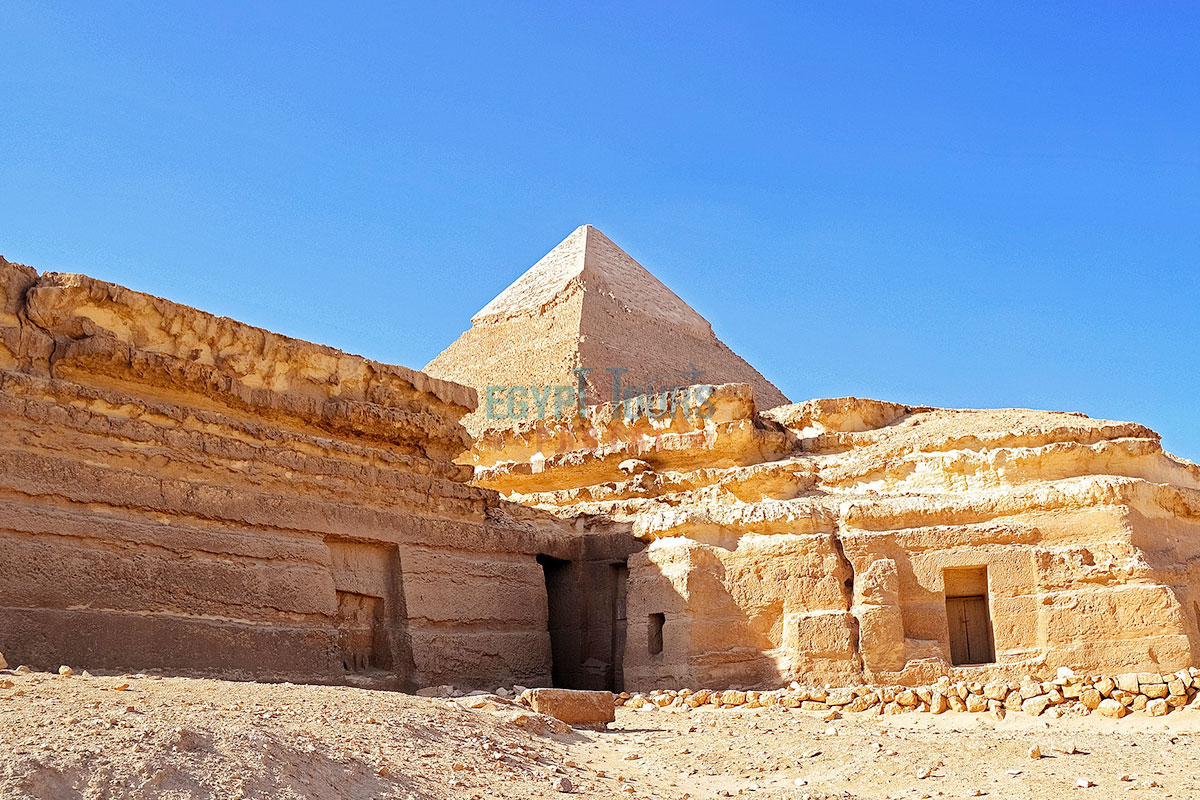
The discovery of Heit al-Ghurab and the Workers’ Cemetery has fundamentally changed how historians and archaeologists view pyramid construction. The evidence overwhelmingly supports the conclusion that pyramid builders were not slaves but skilled workers who played an essential role in state projects. These findings have challenged outdated narratives and reshaped modern perceptions of labor and social organization in ancient Egypt.
By highlighting the economic, technological, and administrative sophistication of the pyramid workforce, the discovery of the Workers’ Cemetery has contributed to a more accurate and inclusive historical narrative, emphasizing the role of non-elite individuals in shaping ancient civilizations.
The Giza Workers’ Cemetery and Village stand as testaments to the laborers who built some of the most enduring monuments in human history. These findings prove that pyramid builders were not slaves, but well-respected, state-supported workers who lived in organized settlements, received medical care, and were honored in death. Their burial practices, religious beliefs, and skilled craftsmanship demonstrate that they were an integral part of ancient Egyptian society, not merely nameless laborers.
By embracing this new understanding, we not only rewrite the history of pyramid construction but also pay homage to the tens of thousands of individuals whose ingenuity, skill, and dedication helped create the wonders of the ancient world. Choose your favorite Egypt Vacation packages and Nile River Cruises to uncover the brilliant minds and strong will of the ancient Egyptians.
Private 4 Days Cairo Tour Packages 4 days Cairo Egypt tour package will offer a bles...
Tour Location: Cairo – Giza...
Stunning 5 Days Cairo and Alexandria Tour Package 5 days Cairo and Alexandria tour p...
Tour Location: Cairo/Giza/Alexandria...
Exceptional 6 Days Cairo, Luxor & Aswan Tour Package 6 days Cairo, Luxor & A...
Tour Location: Cairo/Giza/Aswan/Luxor...
Amazing 7 Days Cairo and Hurghada Holiday 7 Days Cairo & Hurghada holiday will e...
Tour Location: Cairo – Giza – Hurgh...
The entire country of Egypt deserve to be explored with its every heavenly detail but there are places that must be seen before any other such as the breathtaking Hurghada's red sea, The wonders of Cairo the pyramids of Giza, the great sphinx, the Egyptian Museum, Khan El Khalili Bazaar, the wonders of Luxor like Valley of the Kings, Karnak & Hatshepsut temple and the wonders of Aswan such as Abu Simbel temples, Philea temple, Unfinished obelisk and The Wonders of Alexandria like Qaitbat Citadel, Pompey's Pillar and Alexandria Library. Read more about the best places to visit in Egypt.
If you want to apply for a Visa On Arrival that lasts for 30 days then you should be one of the eligible countries, have a valid passport with at least 6 months remaining and pay 25$ USD in cash, as for the E-Visa for 30 day you should have a valid passport for at least 8 months, complete the online application, pay the e-visa fee then print the e-visa to later be presented to the airport border guard. You could also be one of the lucky ones who can obtain a free visa for 90 days. Read more about Egypt travel visa.
Egypt has a variety of delicious cuisines but we recommend “Ful & Ta’meya (Fava Beans and Falafel)”, Mulukhiya, “Koshary”, a traditional Egyptian pasta dish, and Kebab & Kofta, the Egyptian traditional meat dish.
The best time to travel to Egypt is during the winter from September to April as the climate becomes a little tropical accompanied by a magical atmosphere of warm weather with a winter breeze. You will be notified in the week of your trip if the Climate is unsafe and if any changes have been made.
You should pack everything you could ever need in a small bag so you could move easily between your destinations.
We have been creating the finest vacations for more than 20 years around the most majestic destinations in Egypt. Our staff consists of the best operators, guides and drivers who dedicate all of their time & effort to make you have the perfect vacation. All of our tours are customized by Travel, Financial & Time consultants to fit your every possible need during your vacation. It doesn't go without saying that your safety and comfort are our main priority and all of our resources will be directed to provide the finest atmosphere until you return home.
You will feel safe in Egypt as the current atmosphere of the country is quite peaceful after the government took powerful measures like restructuring the entire tourist police to include all the important and tourist attractions in Egypt. Read more about is it safe to travel to Egypt.
Wear whatever feels right and comfortable. It is advised to wear something light and comfortable footwear like a closed-toe shoe to sustain the terrain of Egypt. Put on sun block during your time in Egypt in the summer to protect yourself from the sun.
The best activity is by far boarding a Nile Cruise between Luxor and Aswan or Vise Versa. Witness the beauty of Egypt from a hot balloon or a plane and try all the delicious Egyptian cuisines and drinks plus shopping in old Cairo. Explore the allure and wonders of the red sea in the magical city resorts of Egypt like Hurghada and many more by diving and snorkeling in the marine life or Hurghada. Behold the mesmerizing western desert by a safari trip under the heavenly Egyptian skies.
There are a lot of public holidays in Egypt too many to count either religious or nation, the most important festivals are the holy month of Ramadan which ends with Eid Al Fitr, Christmas and new years eve. Read more about festivals & publich holidays in Egypt.
Egypt is considered to be one of the most liberal Islamic countries but it has become a little bit conservative in the last couple of decades so it is advised to avoid showing your chest, shoulders or legs below the knees.
Arabic is the official language and Most Egyptians, who live in the cities, speak or understand English or at least some English words or phrases. Fewer Egyptians can speak French, Italian, Spanish, and German. Professional tour guides, who work in the tourism sector, are equipped to handle visitors who cannot speak Arabic and they will speak enough English and other languages to fulfill the needs of all our clients.
The fastest way is a car, of course, a taxi. If you are in Cairo ride a white taxi to move faster or you could board the fastest way of transportation in Egypt metro if the roads are in rush hour.
The temperature in Egypt ranges from 37c to 14 c. Summer in Egypt is somehow hot but sometimes it becomes cold at night and winter is cool and mild. The average of low temperatures vary from 9.5 °C in the wintertime to 23 °C in the summertime and the average high temperatures vary from 17 °C in the wintertime to 32 °C in the summertime. The temperature is moderate all along the coasts.
It is the home of everything a traveler might be looking for from amazing historical sites dating to more than 4000 years to enchanting city resorts & beaches. You will live the vacation you deserve as Egypt has everything you could possibly imagine.









